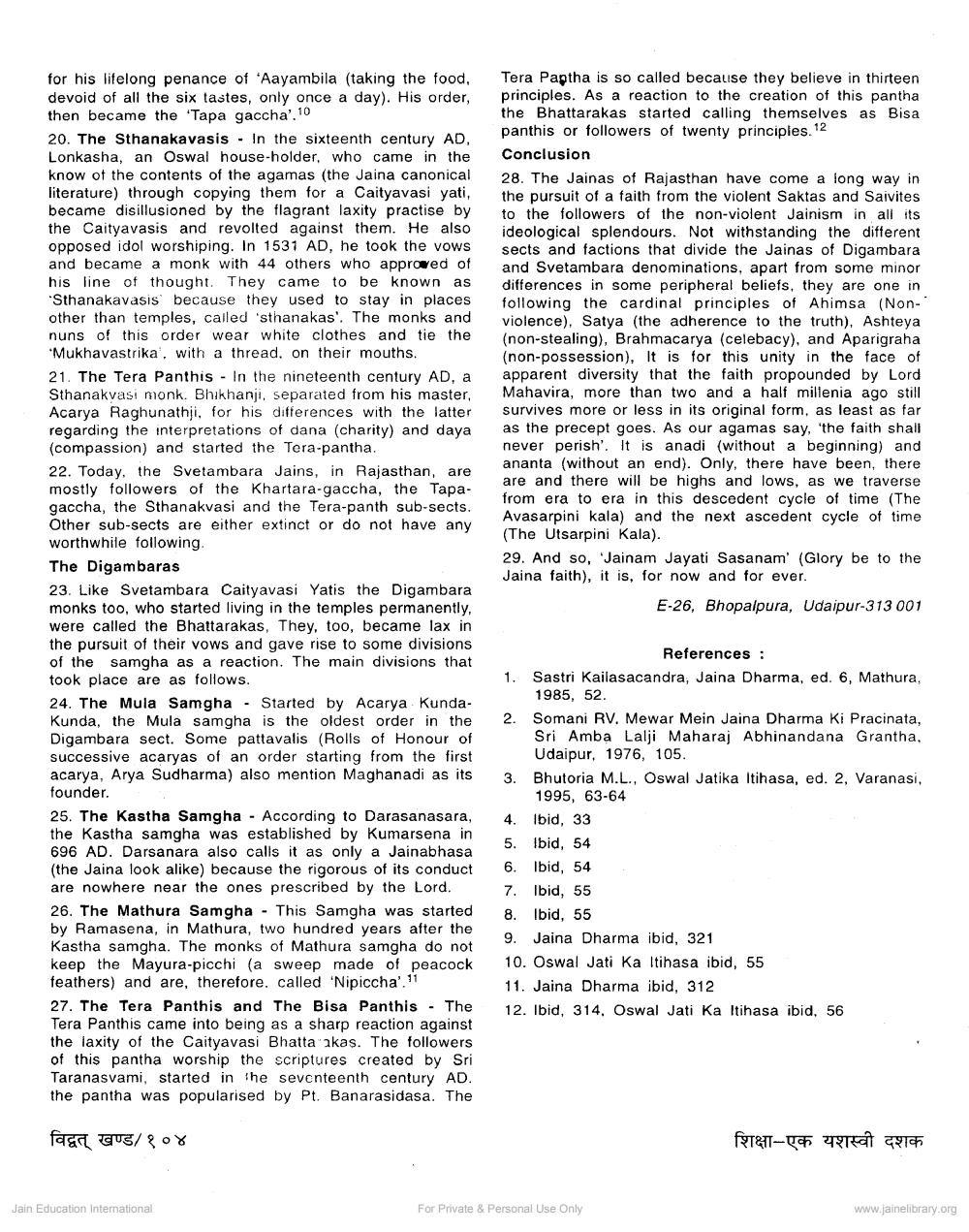________________
Tera Paptha is so called because they believe in thirteen principles. As a reaction to the creation of this pantha the Bhattarakas started calling themselves as Bisa panthis or followers of twenty principles. 12 Conclusion 28. The Jainas of Rajasthan have come a long way in the pursuit of a faith from the violent Saktas and Saivites to the followers of the non-violent Jainism in all its ideological splendours. Not withstanding the different sects and factions that divide the Jainas of Digambara and Svetambara denominations, apart from some minor differences in some peripheral beliefs, they are one in following the cardinal principles of Ahimsa (Nonviolence), Satya (the adherence to the truth), Ashteya (non-stealing), Brahmacarya (celebacy), and Aparigraha (non-possession), it is for this unity in the face of apparent diversity that the faith propounded by Lord Mahavira, more than two and a half millenia ago still survives more or less in its original form, as least as far as the precept goes. As our agamas say, 'the faith shall never perish. It is anadi (without a beginning) and ananta (without an end). Only, there have been, there are and there will be highs and lows, as we traverse from era to era in this descedent cycle of time (The Avasarpini kala) and the next ascedent cycle of time (The Utsarpini Kala). 29. And so, Jainam Jayati Sasanam (Glory be to the Jaina faith), it is, for now and for ever.
for his lifelong penance of 'Aayambila (taking the food, devoid of all the six tastes, only once a day). His order, then became the 'Tapa gaccha'.10 20. The Sthanakavasis - In the sixteenth century AD, Lonkasha, an Oswal house-holder, who came in the know of the contents of the agamas (the Jaina canonical literature) through copying them for a Caityavasi yati, became disillusioned by the flagrant laxity practise by the Caityavasis and revolted against them. He also opposed idol worshiping. In 1531 AD, he took the vows and became a monk with 44 others who approved of his line of thought. They came to be known as Sthanakavasis because they used to stay in places other than temples, called 'sthanakas'. The monks and nuns of this order wear white clothes and tie the Mukhavastrika', with a thread. on their mouths. 21. The Tera Panthis - In the nineteenth century AD, a Sthanakvasi monk. Bhikhanji, separated from his master, Acarya Raghunathji, for his differences with the latter regarding the interpretations of dana (charity) and daya (compassion) and started the Tera-pantha. 22. Today, the Svetambara Jains, in Rajasthan, are mostly followers of the Khartara-gaccha, the Tapagaccha, the Sthanakvasi and the Tera-panth sub-sects. Other sub-sects are either extinct or do not have any worthwhile following The Digambaras 23. Like Svetambara Caityavasi Yatis the Digambara monks too, who started living in the temples permanently were called the Bhattarakas, They, too, became lax in the pursuit of their vows and gave rise to some divisions of the samgha as a reaction. The main divisions that took place are as follows. 24. The Mula Samgha - Started by Acarya KundaKunda, the Mula samgha is the oldest order in the Digambara sect. Some pattavalis (Rolls of Honour of successive acaryas of an order starting from the first acarya, Arya Sudharma) also mention Maghanadi as its founder. 25. The Kastha Samgha - According to Darasanasara, the Kastha samgha was established by Kumarsena in 696 AD. Darsanara also calls it as only a Jainabhasa (the Jaina look alike) because the rigorous of its conduct are nowhere near the ones prescribed by the Lord. 26. The Mathura Samgha - This Samgha was started by Ramasena, in Mathura, two hundred years after the Kastha samgha. The monks of Mathura samgha do not keep the Mayura-picchi (a sweep made of peacock feathers) and are, therefore. called 'Nipiccha'." 27. The Tera Panthis and The Bisa Panthis - The Tera Panthis came into being as a sharp reaction against the laxity of the Caityavasi Bhatta akas. The followers of this pantha worship the scriptures created by Sri Taranasvami, started in the seventeenth century AD. the pantha was popularised by Pt. Banarasidasa. The
E-26, Bhopalpura, Udaipur-313 001
References : 1. Sastri Kailasacandra, Jaina Dharma, ed. 6, Mathura,
1985, 52. 2. Somani RV, Mewar Mein Jaina Dharma Ki Pracinata,
Sri Amba Lalji Maharaj Abhinandana Grantha,
Udaipur, 1976, 105. 3. Bhutoria M.L., Oswal Jatika Itihasa, ed. 2, Varanasi,
1995, 63-64 4. Ibid, 33 5. Ibid, 54 6. Ibid, 54 7. Ibid, 55 8. Ibid, 55 9. Jaina Dharma ibid, 321 10. Oswal Jati Ka Itihasa ibid, 55 11. Jaina Dharma ibid, 312 12. Ibid, 314, Oswal Jati Ka Itihasa ibid. 56
विद्वत् खण्ड/१०४
शिक्षा-एक यशस्वी दशक
Jain Education International
For Private & Personal Use Only
www.jainelibrary.org




